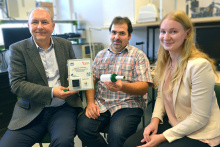Date added: 2022-01-05
Rapid COVID-19 screening

– Our method is not as accurate as the currently used tests, however it is faster, considerably cheaper and more pleasant than the nasopharyngeal specimen collection. Therefore, it will prove useful as a screening method that allows initial confirmation of infection and recommendation for the accurate test – underlines Prof. Janusz Smulko, head of the Department of Metrology and Optoelectronics at Gdańsk Tech Faculty of Electronics, Telecommunications and Informatics. – We do not detect the RNA of the virus, but the effects of the exhaled volatile organic compounds (VOC) that result from dysmetabolism caused by infection. Such systems can be particularly useful if the pandemic continues to develop, as COVID-19 is predicted to be a seasonal disease, which early diagnosis allows for prescribing appropriate medication, blocking the disease from developing and limiting dangerous complications.
Result within a minute
The device is user-friendly and the examination is limited to pressing a few buttons.
– This device utilizes BioVOCTMbreath sampler with a disposable mouthpiece resembling a large syringe used in breath composition analysis techniques. The final phase of breathing is the most important as VOC concentration is the highest at that point. Subsequently, the device sucks the content of the syringe into a small chamber with sensors and starts the analysis – explains Andrzej Kwiatkowski, Ph.D. Eng. from the Department of Metrology and Optoelectronics.
Currently, the result is obtained within 10 minutes .
– However, this is excess time. During the research on the device, we wanted all sensors to have more time reserve than required, in order to stabilize the working conditions. We estimate that this time could be shorter, at the level of one minute – emphasizes Andrzej Kwiatkowski, Ph.D. Eng.
In between the measurements, the device cleans itself to get rid of the residues of previous samples. The device is supplied from a grid, but it can also be powered e.g. from a car or battery, and use wireless data transmission.
Relying on available and energy-efficient sensors
The scientists relied on commercially available and prototype, small-size sensors, developed simultaneously during other research projects.
– Our idea was to prepare sensors that may not be so selective, but are widely available and simultaneously consume less energy, so that the devices could be installed in many places, also in countries where, due to costs, it is not possible to conduct extensive COVID-19 diagnostics - says Prof. Janusz Smulko.
The device uses solutions developed a few years ago at Gdańsk Tech during the EU research project TROPSENSE, which concerned the exhaled air diagnosis of tropical diseases (dengue, leishmaniasis, echinococcosis) using exhaled air.
Cooperation with doctors
As part of the project "Rapid screening diagnosis of SARS Cov-2 infection using exhaled air test" financed by Gdańsk University of Technology from the Combating Coronavirus program, scientists from Gdańsk Tech scientists cooperate with Katarzyna Sikorska, M.D., Ph.D., Associate Professor at MUG and doctor Sebastian Borys of the Department of Tropical and Parasitic Diseases at the University Center of Maritime and Tropical Medicine in Gdynia, clinical hospital of the Medical University of Gdańsk (since the beginning of the SARS-CoV-2 virus pandemic, University Center of Maritime and Tropical Medicine has been a key Pomerania center in the fight against the pandemic and the first hospital fully prepared to provide professional care for coronavirus infected patients).
As emphasized by Prof. Katarzyna Sikorska, head of the clinic, the method based on a quick breath composition analysis avoids the patient’s unpleasant experience related to the correct taking of a nasopharyngeal swab for the PCR or antigen test, and allows for an express result.
– Some of the technologies under development allow direct detection of the virus. Other, detecting changes in the composition of the air exhaled by an infected person, can serve as an initial, quick, easy-to-perform screening test, segregating the tested persons - explains Prof. Katarzyna Sikorska. - Such a method may prove particularly useful if it is important to test a large number of people in a short time, e.g. testing passengers at airports, guests in restaurants, participants of mass cultural events, employees of large industrial plants, students and students of educational institutions . A similar device was already pre-approved for use by Singapore travelers and used in the Netherlands to test port workers.
As Gdańsk Tech scientists emphasize, the tested method may prove an interesting alternative to the currently used routine diagnostic methods. The test, easy to perform under various conditions, fits in the idea of developing ideal tools for rapid, mass and low-cost testing of SARS-CoV-2 infection.
- The device is in the hospital and measurements are taken there. We are currently working on the final analysis of the results, which we will present in a publication, and developing further modifications of the device – says Andrzej Kwiatkowski, Ph.D. Eng.
Solution recognized overseas
Detailed information on the device, jointly developed by Prof. Janusz Smulko, Andrzej Kwiatkowski, Ph.D. Eng. and Katarzyna Drozdowska, M.Sc., are described in the article „Embedded gas sensing setup for air samples analysis”.
The invention from designed at Gdańsk Tech has been acknowledged by the American media popularizing scientific achievements. An article on this topic was published at eurekalert.org.


